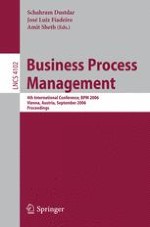2006 | Buch
Business Process Management
4th International Conference, BPM 2006, Vienna, Austria, September 5-7, 2006. Proceedings
herausgegeben von: Schahram Dustdar, José Luiz Fiadeiro, Amit P. Sheth
Verlag: Springer Berlin Heidelberg
Buchreihe : Lecture Notes in Computer Science
